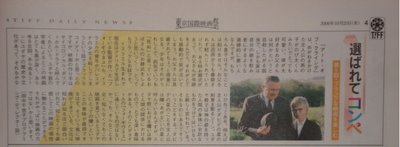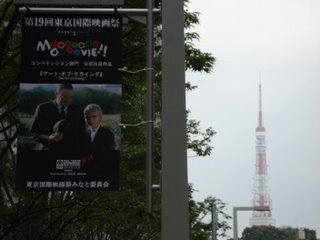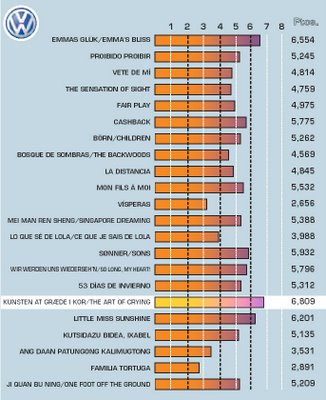(Click icons for reading the original reviews - all texts are auto translated by Babelfish)
In french:

The art of crying of Peter Schonau Fog, Danemarck, Zabaltegi.
Masterly! Already the title: art to cry! Denmark, the Seventies. Still a history of family. Beautiful fair children, an attentive mother, a dairy father, who makes the round while his wife holds the cheese store. Nanan! With through the glasses of Allan, the little boy, we discover little by little as an onion that one peels skin by skin, the secrecies of this family. The father who threatens to commit suicide each night, the mother which throws the sponge, the girl which will calm her father, the big brother who comes and who leaves, the neighbors, customers, the priest, the cemetery and speeches of the dad who make cry everyone. Hard, hard to find itself there without charts, when one loves his father but whom one discovers little by little, which it is not the mast which holds the capital. An interpretation with the razor. Images on glazed paper of this so pretty Denmark, which, it should be said in passing, account the largest rate of suicidesŠ intimate Festen, distilled hand of Master by a realizer who can direct his actors. And an actor who plays the part of the father, parano and pervert with a little more nuances than our Nathalie Baye in My son with me.
In spanish
I LOVE (I CREATE) MY FAMILY
Terrible, desasosegante, the disquieting thing; what anesthesia in dry disturbs but you at the same time she is that in this Danish film everything seems to happen of a natural way, logical, traditional, atavic. As if the form to act of all and each one of their ambivalent, ambiguous and very cabrones personages were recorded in their DNA from the beginning of the times in the south of Jutlandia. The one that the father of Allan wants to commit suicide every five minutes, the one that the mother takes tablets and more tablets to disconnect, the one that Allan thinks that it is normal to make eróticos jueguecitos him to papi to console to him, the one that a doctor anyone, a generalist one immediately, decides the entrance of the sister in a frenopático, is things that are accepted because all suppose (rather, they have learned) that thus have been from always, it is and it will be.
The Art of Crying is of a coldness so that it leaves to the spectator with the generous soul. Of a chosen coldness, assumed and taken to the limit with all its consequences. No, they do not think about Lynch. He is not that. It is not that unhealthy world class. Here EVIL (capital and admiration) it has taken possession from souls and bodies. And those bodies, those souls, ignore that it is thus. The Horrible thing is already meat of its meat.
Addictive and awarded drama, the Volkswagen Prize of the Youth of the own festival of San Sebastián took, that treats a thorny subject as amply it is the child abuse. But this Danish film has osadía to portray to twigs with a certain interest for the somewhat Machiavellian spectators and victimas, incredible performance of the young person Jannik Lorenzen in its paper of the Allan upstart.
The action trascurre in Jutlandia, province of the south of Denmark, at the beginning of the Seventies. The family of the Allan young person is a true disaster. His father often has nervous crises and threatens committing suicide regularly. Her mother has thrown the towel and this in its world, its older brother has gone away of house and the small dairy of the family goes worse of every time. It will depend on Allan to maintain the family united. His father lives only for those moments in that he recites his famous and eloquent ones recited that make cry to all the assistants to a funeral. Soon, Allan will make use to make sure that there are sufficient funerales to maintain his contented father. But little by little it will see that his papa is not the person who he creates and when her older sister lets pass the nights in the sofa with her father, Allan will have to choose between the veneration that feels towards its father or the truth of which it happens between papa and his sister in the salita of house.
Film based on the novel of Erling Jepsen, where it counted his memories of childhood. Rolled to little distance of the places where it in fact happened the action and in dialecto that will cause that in own Denmark it is released subtitled. The director tries to give with a history with a humorous air to enter itself in the beginning in the dark side of the plot. But the force of the film is that there is no bloody nor ill-disposed scene, all this treaty of subtle form, but direct, there is no plane for the controversy. It is an intimist drama but that goes much more there that other films with the same subject, since all the personages overflow a humanity, as much the children as the own father. That causes that we do not feel like discomforts in happening of the action, somewhat non-uniform thing but that certain. As far as the distribution it is necessary to emphasize to Jannik Lorenzen by his paper of Allan and to Julie Kolbeck, like descarriada sister of Allan. They two, next to Jesper Asholt in the paper of afflicted family father, sustained the film with majestic interpretations.
Authentic surprise of the Festival of San Sebastián, this film is used for those incredulous ones that thinks that in Denmark the cinema only exists Dogma and nothing else.

Recently, in this same festival, we have had the opportunity to see the film aid "
Mon fils to moi", that also it treated domestic subjects. It did front, showing the problem without adornments, and if it is wanted, without poetry. The film that now I criticize approaches a similar problem but of one more a more implicit way, mainly in the beginning, from the innocent vision of a boy. In my opinion he is superior, by the commented thing and other questions. Pain is one that we have not seen it aid, although at heart little matters.
Humor, black, cruel humor sometimes, flavors east familiar drama, making it thus more interesting and, simultaneously, obtaining a greater impact of its thematic one. With great scenes like the one of the first monólogo of the father in the cemetery, when the boy defies with his glance the person who can threaten her father.
A boy, the actor, who makes a work fantastic, specially for its age. Besides to have a perfect image, with its glasses and their so blond hair, very to tone with the ambientación. And like him, the rest of the actors. The father eats the film. The girl, with her face of going transmits a sensation of incredible resignation.
All this drawn with a fine and elegant photography, alive but nonestridentes colors. Two adjectives, fine and such elegant, can be applied to a direction that promises to obtain new good films that I hope bring to the festival and which they have the same scriptwriter. A counted history of original way but that speech of as old domestic horrors as the family.

With respect to my section, Zabaltegi, to emphasize the good mean level of the projections (far better that the official section to my to understand), in that I found the one who was better film to me from the festival in main lines, the Danish "The art of crying". It is history from the point of view of a small monkey, rubito and innocent of the life of his family, in which his father lacks all security in itself and night wants to force suicide on each (forward edge of dialogue is "in my house, is necessary to be well wide-awake at night because it is when my father is wanted to force suicide on"), the mother is bitter and the sister survives as she can. Sight thus, seems a melodrama to spurt, but nevertheless the film obtains an incredible balance between crude comedy, situations, and beauty of images, mounted with style, dynamism, intensity and a music to frame. When you take to several 4 days sleeping little and seeing pelis the day, and to 12 in the morning you stick 2 hours to the screen, they go flying, and all the room applauds to rage after reir and to cry... is that something has the film. It had raised well them but insuffrable, wishing that they finished. This no. He was agile and entertainment, treating several subjects like pedofilia from innate kindness to the man, as Stone in "World Trade Center" says (only reason why the its boring tear epic is acceptable, kindness and union arisen after badly from the attacks). It is difficult to describe to me I hope much that I liked "The art of Crying", and only to be able to return to see it to see if my enthusiasm is just. Although, to gain the prize of the young jury with as much difference speaking of which it speaks much... has is film that, of to have gone to official, safe, safe section, that it had won (although shared with the Iranian of gold, since there is no another one).
1 The art of Crying 10 Denmark
2 The boss of it all 10 Denmark
3 Babel 9 the USA of Iñárritu
4 Singapore Dreaming 9 Singapur
5 Glue 9 Argentina, produced by Isabel Coixet
6 Sleeping dog´s lie 8 the USA
7 Fair play 8 France
8 Sons 8 Noruega
9 Halfmoon 8 Iran
10- Elle´s bliss 7 Germany
11- Mon fils à moi 7 France
12- Delirious 7 the USA, better script and director to Tom DiCillo
13- Hana 7 Japan de Kore-eda "nobody knows"
14- Zulo 7 Spain
15- Factotum 7 Noruega/Francia/USA..., with the unjustifiable Donostia Matt Dillon doing well of tio hard
16- Children of men 7 USA/España... of Cuarón
17- The Old Garden 7 Korea, of Im Sang soon
18- Backwoods 7 Spain, with Gary Oldman and Aitana Sanchez Gijón
19- Chronicle of a flight 7 Argentina
20- Vete of my 6 Spain, better actor to Juan Diego
21- Prohibited to prohibit 6 Brazil
22- the way of San Diego 6 Argentina, special mention of the jury
23- Cashback 6 England
24- Little miss sunshine 6 the USA, prize of the public in front of Babel
25- ChineseGhosts 5 , inauguration
26- World trade to center 5 the USA
27- Lonely hearts 5 the USA, closing (good Gandolfini, boring script)
28- Children 4 Islandia
29- Copying Beethoven 4 USA/Alemania
30- Chinese One foot off theground 4
31- tail Tiger´s 3 Ireland, John Boorman
32- What I know of Lola 3 Francia/España
33- the lives of Celia 3 Spain
34- They are long! 2 Germany, original music of Mardi Grass
35- the distance 1 España
36- Eves 1 Argentina
37- the family turtle 1 Mexico


(
Babelfish can be used to translate spanish and french. Copy the url(http:// ect.) into babelfish and change the language settings. )






















